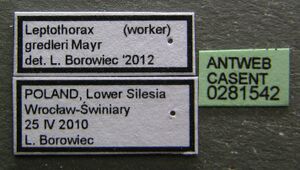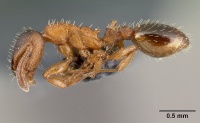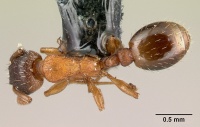Leptothorax gredleri
| Leptothorax gredleri | |
|---|---|

| |
| Scientific classification | |
| Kingdom: | Animalia |
| Phylum: | Arthropoda |
| Class: | Insecta |
| Order: | Hymenoptera |
| Family: | Formicidae |
| Subfamily: | Myrmicinae |
| Tribe: | Crematogastrini |
| Genus: | Leptothorax |
| Species: | L. gredleri |
| Binomial name | |
| Leptothorax gredleri Mayr, 1855 | |
Alate queens of this species practice female calling, i.e., they leave their natal nest, climb onto vegetation, and release pheromone from their extruded sting to attract males.
Photo Gallery
Identification
Keys including this Species
Distribution
Latitudinal Distribution Pattern
Latitudinal Range: 59.930404° to 42.7°.
| North Temperate |
North Subtropical |
Tropical | South Subtropical |
South Temperate |
- Source: AntMaps, Seifert (2023)
Distribution based on Regional Taxon Lists
Palaearctic Region: Austria (type locality), Belgium, Croatia, Czech Republic, France, Germany, Greece, Hungary, Iberian Peninsula, Montenegro, Norway, Poland, Russian Federation, Slovenia, Spain, Sweden, Switzerland.
Distribution based on AntMaps
Distribution based on AntWeb specimens
Check data from AntWeb
Countries Occupied
| Number of countries occupied by this species based on AntWiki Regional Taxon Lists. In general, fewer countries occupied indicates a narrower range, while more countries indicates a more widespread species. |

|
Estimated Abundance
| Relative abundance based on number of AntMaps records per species (this species within the purple bar). Fewer records (to the left) indicates a less abundant/encountered species while more records (to the right) indicates more abundant/encountered species. |

|
Biology
Nest in small sticks in pine forest.
Females practice female calling outside their natal nest, then either found a new nest alone, seek adoption in another nest, or return to their own nest. Colonies that contain more than one queen exhibit functional monogyny.
Bernadou et al. (2016) studied the behavior of newly mated queens. They found queens can distinguish their natal nest using cuticular hydrocarbons found on a substrate. Overall there was a preference for newly mated queens to choose a nest previously used by their natal nestmates. For queens adopted back into their natal nest within laboratory nests, a large majority of these queens were killed within the eight weeks. They concluded newly mated queens may preferentially re-inhabit their natal nest after mating, then subsequently leave before they are killed.
Flight Period
| X | X | ||||||||||
| Jan | Feb | Mar | Apr | May | Jun | Jul | Aug | Sep | Oct | Nov | Dec |
Source: antkeeping.info.
- Check details at Worldwide Ant Nuptial Flights Data, AntNupTracker and AntKeeping.
- Explore: Show all Flight Month data or Search these data. See also a list of all data tables or learn how data is managed.
Association with Other Organisms
 Explore: Show all Associate data or Search these data. See also a list of all data tables or learn how data is managed.
Explore: Show all Associate data or Search these data. See also a list of all data tables or learn how data is managed.
This species is a host for the ant Harpagoxenus sublaevis (a slave maker) (Foitzik et al., 2003; Guillem et al., 2014; de la Mora et al., 2021).
Life History Traits
- Queen number: monogynous (Frumhoff & Ward, 1992) (functional monogyny)
Castes
Worker
Images from AntWeb
   
| |
| Worker. Specimen code casent0281542. Photographer Estella Ortega, uploaded by California Academy of Sciences. | Owned by CAS, San Francisco, CA, USA. |
Queen
Images from AntWeb
   
| |
| Queen (alate/dealate). Specimen code casent0281541. Photographer Estella Ortega, uploaded by California Academy of Sciences. | Owned by CAS, San Francisco, CA, USA. |
    
| |
| Syntype of Leptothorax gredleri. Queen (alate/dealate). Specimen code casent0901772. Photographer Ryan Perry, uploaded by California Academy of Sciences. | Owned by NHMUK, London, UK. |
Nomenclature
The following information is derived from Barry Bolton's Online Catalogue of the Ants of the World.
- gredleri. Leptothorax gredleri Mayr, 1855: 438 (w.q.) AUSTRIA. Schenck, 1861: 196 (m.). Combination in L. (Mychothorax): Forel, 1915d: 26. Junior synonym of muscorum: Roger, 1862c: 296. Revived from synonymy as subspecies of muscorum: Forel, 1874: 87. Raised to species: Bondroit, 1918: 122. Subspecies of muscorum: Dalla Torre, 1893: 125; Emery, 1916b: 176; Emery, 1924d: 262; Stitz, 1939: 163; Novak & Sadil, 1941: 90. Junior synonym of muscorum: Brown, 1955a: 47 (in text). Revived from synonymy and status as species: Buschinger, 1966b: 165. See also: Bernard, 1967: 389; Baroni Urbani, 1971c: 98; Pisarski, 1975: 24; Kutter, 1977c: 129; Seifert, 2007: 225.
Description
Karyotype
- n = 11 (Germany; Switzerland) (Buschinger et al., 1980; Fischer, 1987; Loiselle et al., 1990).
References
- Baer, B. 2011. The copulation biology of ants (Hymenoptera: Formicidae). Myrmecological News 14: 55-68.
- Baroni Urbani, C. 1971c. Catalogo delle specie di Formicidae d'Italia (Studi sulla mirmecofauna d'Italia X). Memorie della Societa Entomologica Italiana 50: 5-287 (page 98, Status as species)
- Bernadou, A., J. Ruther, and J. Heinze. 2015. Avoid mistakes when choosing a new home: Nest choice and adoption of Leptothorax ant queens. Journal of Insect Physiology. 79:88-95. doi:10.1016/j.jinsphys.2015.06.008
- Bernard, F. 1967a [1968]. Faune de l'Europe et du Bassin Méditerranéen. 3. Les fourmis (Hymenoptera Formicidae) d'Europe occidentale et septentrionale. Paris: Masson, 411 pp. (page 389, Status as species)
- Blatrix R., Lebas C., Wegnez P., Galkowski C., Buschinger A., 2013. New data on the distribution of Leptothorax pacis and L. kutteri, two very rare parasitic ants, and confirmation of the presence of L. gredleri in France (Hymenoptera, Formicidae). Revue de l’Association Roussillonnaise d’Entomologie, 22, 85-91.
- Bondroit, J. 1918. Les fourmis de France et de Belgique. Ann. Soc. Entomol. Fr. 87: 1-174 (page 122, Status as species)
- Borowiec, L. 2014. Catalogue of ants of Europe, the Mediterranean Basin and adjacent regions (Hymenoptera: Formicidae). Genus (Wroclaw) 25(1-2): 1-340.
- Buschinger, A. 1966c. Leptothorax (Mychothorax) muscorum Nylander und Leptothorax (M.) gredleri Mayr zwei gute Arten. Insectes Soc. 13: 165-172. (page 165, Status as species)
- Cantone S. 2017. Winged Ants, The Male, Dichotomous key to genera of winged male ants in the World, Behavioral ecology of mating flight (self-published).
- Csosz, S. 2001. Taxonomical and distributional notes on two new and a rare Leptothorax Mayr, 1855 species for the Hungarian ant fauna (Hymenoptera, Formicidae). Ann. Hist.-Nat. Mus. Natl. Hung. 93: 99-106 (new record for Hungary)
- Csősz, S., Báthori, F., Gallé, L., Lőrinczi, G., Maák, I., Tartally, A., Kovács, É., Somogyi, A.Á., Markó, B. 2021. The myrmecofauna (Hymenoptera: Formicidae) of Hungary: Survey of ant species with an annotated synonymic inventory. Insects 16;12(1):78 (doi:10.3390/insects12010078).
- Csosz, S., Marko, B., Galle, L. 2011. The myrmecofauna (Hymenoptera: Formicidae) of Hungary: an updated checklist. North-Western Journal of Zoology 7: 55-62.
- Czechowski, W., Radchenko, A., Czechowska, W. 2002. The ants (Hymenoptera, Formicidae) of Poland. MIZ PAS Warsaw.
- Dalla Torre, K. W. von. 1893. Catalogus Hymenopterorum hucusque descriptorum systematicus et synonymicus. Vol. 7. Formicidae (Heterogyna). Leipzig: W. Engelmann, 289 pp. (page 125, Variety/subspecies of muscorum)
- Dekoninck, W., Ignace, D., Vankerkhoven, F., Wegnez, P. 2012. Verspreidingsatlas van de mieren van België. Bulletin de la Société royale belge d’Entomologie 148: 95-186.
- Dubovikoff, D.A., Yusupov, Z.M. 2017. Family Formicidae - Ants. In Belokobylskij S. A. and A. S. Lelej: Annotated catalogue of the Hymenoptera of Russia. Proceedingss of the Zoological Institute of the Russian Academy of Sciences 6: 197-210.
- Emery, C. 1916a [1915]. Fauna entomologica italiana. I. Hymenoptera.-Formicidae. Bull. Soc. Entomol. Ital. 47: 79-275 (page 176, Variety/subspecies of muscorum)
- Emery, C. 1924f [1922]. Hymenoptera. Fam. Formicidae. Subfam. Myrmicinae. [concl.]. Genera Insectorum 174C: 207-397 (page 262, Variety/subspecies of muscorum)
- Forel, A. 1874. Les fourmis de la Suisse. Systématique, notices anatomiques et physiologiques, architecture, distribution géographique, nouvelles expériences et observations de moeurs. Neue Denkschr. Allg. Schweiz. Ges. Gesammten Naturwiss. 26: 1-452 (page 87, Revived from synonymy as variety of muscorum)
- Forel, A. 1915d. Fauna insectorum helvetiae. Hymenoptera. Formicidae. Die Ameisen der Schweiz. Mitt. Schweiz. Entomol. Ges. 12(B Beilage: 1-77 (page 26, Combination in L. (Mychothorax))
- Guillem, R.M., Drijfhout, F., & Martin, S.J. 2014. Chemical deception among ant social parasites. Current Zoology, 60(1), 62-75 (doi:10.1093/czoolo/60.1.62).
- Heinze, J., Lipski, N., Schlehmeyer, K., Holldobler, B. 1995. Colony structure and reproduction in the ant, Leptothorax acervorum. Behavioral Ecology 6(4): 359-367.
- Honorio, R., Doums, C., Molet, M. 2020. Manipulation of worker size diversity does not affect colony fitness under natural conditions in the ant Temnothorax nylanderi. Behavioral Ecology and Sociobiology 74. (doi:10.1007/S00265-020-02885-2).
- Johnson, C.A. 2000. Mechanisms of dependent colony founding in the slave-making ant, Polyergus breviceps Emery (Hymenoptera: Formicidae). Ph.D. thesis, City University of New York.
- Kutter, H. 1977c. Hymenoptera, Formicidae. Insecta Helv. Fauna 6: 1-298 (page 129, Status as species)
- Mayr, G. 1855. Formicina austriaca. Beschreibung der bisher im österreichischen Kaiserstaate aufgefundenen Ameisen, nebst Hinzufügung jener in Deutschland, in der Schweiz und in Italien vorkommenden Arten. Verh. Zool.-Bot. Ver. Wien 5: 273-478 (page 438, worker, queen described)
- Novák, V.; Sadil, J. 1941. Klíc k urcování mravencu strední Evropy se zvlástním zretelem k mravencí zvírene Cech a Moravy. Entomol. Listy 4: 65-115 (page 90, Variety/subspecies of muscorum)
- Oberstadt, B.; Heinze, J. 2003. Mating biology and population structure of the ant, Leptothorax gredleri. Insectes Soc. 50: 340-345 (page 340, see also)
- Pisarski, B. 1975. Mrówki Formicoidea. Kat. Fauny Pol. 26: 3-85 (page 24, Status as species)
- Roger, J. 1862c. Synonymische Bemerkungen. 1. Ueber Formiciden. Berl. Entomol. Z. 6: 283-297 (page 296, Junior synonym of muscorum)
- Salata, S., Borowiec, L. 2014. New localities of some rare ant species (Hymenoptera: Formicidae). Wiadomości Entomologiczne 33, 77-79.
- Satria, R. 2017. Taxonomy of the ant genus Odontomachus (Hymenoptera: Formicidae: Ponerinae) in the Indo-Chinese and Indo-Malayan subregions. Ph.D. thesis, Tokyo Metropolitan University.
- Schenck, C. F. 1861. Zusätze und Berichtigungen zu der Beschreibung der nassauischen Grabwespen (Heft XII), Goldwespen (Heft XI), Bienen (Heft XIV) und Ameisen (Heft VIII und XI). Jahrb. Ver. Naturkd. Herzogthum Nassau Wiesb. 16: 137-206 (page 196, male described)
- Seifert, B. 2023. Two new species of Formicoxenus Mayr 1855 and Leptothorax Mayr 1855 from Tibet (Hymenoptera: Formicidae). Soil Organisms 95(2), 129-142 (doi:10.25674/SO95ISS2ID315).
- Stitz, H. 1939. Die Tierwelt Deutschlands und der angrenzenden Meersteile nach ihren Merkmalen und nach ihrer Lebensweise. 37. Theil. Hautflüger oder Hymenoptera. I: Ameisen oder Formicidae. Jena: G. Fischer, 428 pp. (page 163, Variety/subspecies of muscorum)
- Yusupov, Z.M. 2014. Two ant species (Hymenoptera, Formicidae) from the Northern Caucasus, new to the fauna of Russia. Entomological Review 94, 286–287 (doi:10.1134/s0013873814020195).
References based on Global Ant Biodiversity Informatics
- Agosti, D. and C.A. Collingwood. 1987. A provisional list of the Balkan ants (Hym. Formicidae) and a key to the worker caste. I. Synonymic list. Mitteilungen der Schweizerischen Entomologischen Gesellschaft, 60: 51-62
- Antarea (Personal Communication - Rumsais Blatrix- 27 April 2018)
- Antarea (at www.antarea.fr on June 11th 2017)
- ArtDatabanken Bugs (via GBIG)
- Bezdecka P. 1996. The ants of Slovakia (Hymenoptera: Formicidae). Entomofauna carpathica 8: 108-114.
- Boer P. 2019. Species list of the Netherlands. Accessed on January 22 2019 at http://www.nlmieren.nl/websitepages/specieslist.html
- Borowiec L. 2014. Catalogue of ants of Europe, the Mediterranean Basin and adjacent regions (Hymenoptera: Formicidae). Genus (Wroclaw) 25(1-2): 1-340.
- Borowiec L., and S. Salata. 2012. Ants of Greece - Checklist, comments and new faunistic data (Hymenoptera: Formicidae). Genus 23(4): 461-563.
- Borowiec M. L. 2009. New data on the occurrence of formicoxenine ants (Hymenoptera: Formicidae) in Poland. Wiadomo?ci Entomologiczne 28: 237-246.
- Borowiec M. L. 2009. Nowe dane o rozmieszczeniu mrówek (Hymenoptera: Formicidae) z plemienia Formicoxenini w Polsce. Wiadomosci Entomologiczne 28: 237-246.
- Bracko G. 2007. Checklist of the ants of Slovenia (Hymenoptera: Formicidae). Natura Sloveniae 9: 15-24
- Bracko, G. 2006. Review of the ant fauna (Hymenoptera:Formicidae) of Croatia. Acta Entomologica Slovenica 14(2): 131-156.
- Bracko, G.. "New species for the ant fauna of Slovenia (Hymenoptera:Formicidae)." Natura Sloneniae 5 (1) (2003): 17-25.
- Bracko, G.. "Review of the ant fauna (Hymenoptera: Formicidae) of Croatia." Acta Entomologica Slovenica Vol 14 st (2006): 131-156.
- Cherix D., and S. Higashi. 1979. Distribution verticale des fourmis dans le Jura vaudois et recensement prelimaire des bourdons (Hymenoptera, Formicidae et Apidae). Bull. Soc. Vaud. Sc. Nat. 356(74): 315-324.
- Collingwood C. A. 1971. A synopsis of the Formicidae of north Europe. Entomologist 104: 150-176
- Collingwood, C. A.. "A provisional list of Iberian Formicidae with a key to the worker caste." EOS (Revista española de entomología) Nº LVII (1978): 65-95.
- Csosz S., B. Marko, K. Kiss, A. Tartally, and L. Galle. 2002. The ant fauna of the Ferto-Hansag National Park (Hymenoptera: Formicidae). In: Mahunka, S. (Ed.): The fauna of the Fert?-Hanság National Park. Hungarian Natural History Museum, Budapest, pp. 617-629.
- Csősz S. 2001. Taxonomical and distributional notes on two new and a rare Leptothorax Mayr, 1855 species for the Hungarian ant fauna (Hymenoptera, Formicidae). Annales Historico-Naturales Musei Nationalis Hungarici 93: 99-106.
- Csősz S., B. Markó, and L. Gallé. 2011. The myrmecofauna (Hymenoptera: Formicidae) of Hungary: an updated checklist. North-Western Journal of Zoology 7: 55-62.
- Czechowski W., A. Radchenko, W. Czechowska and K. Vepsäläinen. 2012. The ants of Poland with reference to the myrmecofauna of Europe. Fauna Poloniae 4. Warsaw: Natura Optima Dux Foundation, 1-496 pp
- Dauber J. 1997. Ameisenfauna einer urbanen landschaft. Naturschutz und Landschaftsplanung 29: 303-309.
- Dekoninck W., P. Wegnez, and L. Cournault. 2009. A list of ant species collected in the surrounding area of Rocher Fredericq (Hockai0 with the first record of Leptothorax gredleri Mayr, 1855 for Belgium. Bulletin S.R.B.E. 145: 22-24.
- Dubovikoff D. A., and Z. M. Yusupov. 2018. Family Formicidae - Ants. In Belokobylskij S. A. and A. S. Lelej: Annotated catalogue of the Hymenoptera of Russia. Proceedingss of the Zoological Institute of the Russian Academy of Sciences 6: 197-210.
- Emery C. 1916. Fauna entomologica italiana. I. Hymenoptera.-Formicidae. Bullettino della Società Entomologica Italiana 47: 79-275.
- Fiedler, K., F. Kuhlmann, B. C. Schlick-Steiner, F. M. Steiner and G. Gebauer. 2007. Stable N-isotope signatures of central European ants assessing positions in a trophic gradient. Insectes Sociaux 54(4):393-402.
- Foitzik S., and Heinze, J. 1999. Non-random size differences between sympatric species of the ant genus Leptothorax (Hymenoptera: Formicidae). Entomologia Generalis 24: 65-74.
- Glaser F., T. Kopf, and K. H. Steiberger. 2003. Ameisen (Hymenoptera: Formicidae) im Frastanzer Ried und den Illauen (Vorarlberg, Österreich) Artenspektrum, Gefährdung und Schutzempfehlungen. Vorarlberger Naturschau 13: 287-310.
- Heinze, J. 1995. The Origin of Workerless Parasites in Leptothorax (S. Str.) (Hymenoptera: Formicidae). Psyche 102 (3-4) :195-214
- Karaman M. G. 2011. A catalogue of the ants (Hymenoptera, Formicidae) of Montenegro. Podgorica: Catalogues 3, Volume 2, Montenegrin Academy of Sciences and Arts, 140 pp.
- Kofler A. 1995. Nachtrag zur Ameisenfauna Osttirols (Tirol, Österreich) (Hymenoptera: Formicidae). Myrmecologische Nachrichten 1: 14-25.
- Lorite P., J. A. Carrillo, M. F. García, and T. Palomeque. 2000. Chromosome numbers in Spanish Formicidae. III. Subfamily Myrmicinae (Hymenoptera). Sociobiology 36: 555-570.
- Neumeyer R., and B. Seifert. 2005. Commented check list of free living ant (Hymenoptera: Formicidae) species of Switzerland. Bulletin de la Societe Entomologique Suisse 78: 1-17.
- Oberstadt, B. and J. Heinze. 2003. Mating biology and population structure of the ant, Leptothorax gredleri. Insectes Sociaux 50:340-345
- Odegaard F. 2013. New and little known ants (Hymenoptera, Formicidae) in Norway. Norwegian Journal of Entomology 60, 172175.
- Petrov I. Z., and C. A. Collingwood. 1992. Survey of the myrmecofauna (Formicidae, Hymenoptera) of Yugoslavia. Archives of Biological Sciences (Belgrade) 44: 79-91.
- Salata S. 2014. Ants (Hymenoptera: Formicidae) of the National Park of the Stołowe Mts. Przyroda Sudetow 17: 161-172.
- Salata S., and L. Borowiec. 2014. New localities of some rare ant species (Hymenoptera: Formicidae). WIAD. ENTOMOL., 33 (1): 77-79.
- Schar S., G Talavera, X. Espadaler, J. D. Rana, A. A. Andersen, S. P. Cover, and R. Vila. 2018. Do Holarctic ant species exist? Trans-Beringian dispersal and homoplasy in the Formicidae. Journal of Biogeography 00: 1-12.
- Schlick-Steiner B. C., and F. M. Steiner. 1999. Faunistisch-ökologische Untersuchungen an den freilebenden Ameisen (Hymenoptera: Formicidae) Wiens. Myrmecologische Nachrichten 3: 9-53.
- Seifert B. 1994. Die freilebenden Ameisenarten Deutschlands (Hymenoptera: Formicidae) und Angaben zu deren Taxonomie und Verbreitung. Abhandlungen und Berichte des Naturkundemuseums Görlitz 67(3): 1-44.
- Steiner F. M., S. Schödl, and B. C. Schlick-Steiner. 2002. Liste der Ameisen Österreichs (Hymenoptera: Formicidae), Stand Oktober 2002. Beiträge zur Entomofaunistik 3: 17-25.
- Sturm P., and H. Distler. 2003. Rote liste gefahrdeter ameisen (Hymenoptera: Formicoidea) Bayerns. In: Bayrisches Landesamt für Umweltschutz (Ed.). Rote Liste gefährdeter Tiere Bayerns. 208-212.
- Yusupov Z. M. 2014. Two Ant Species (Hymenoptera, Formicidae) from the Northern Caucasus, New to the Fauna of Russia. Entomological Review 94(2): 286-287.
- Pages using DynamicPageList3 parser function
- Photo Gallery
- North temperate
- FlightMonth
- Ant Associate
- Host of Harpagoxenus sublaevis
- Karyotype
- Species
- Extant species
- Formicidae
- Myrmicinae
- Crematogastrini
- Leptothorax
- Leptothorax gredleri
- Myrmicinae species
- Crematogastrini species
- Leptothorax species
- Need Overview
- Need Body Text


